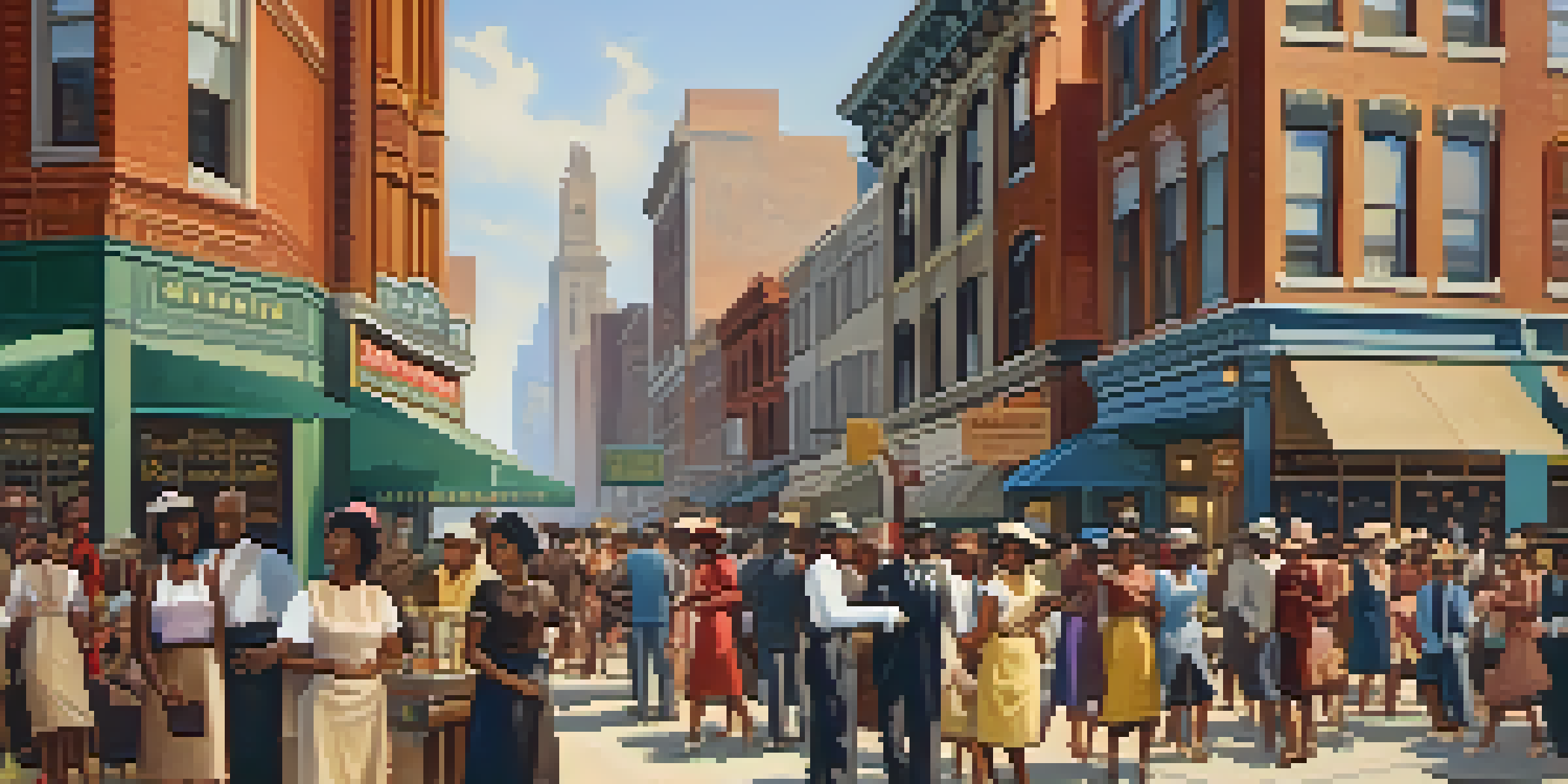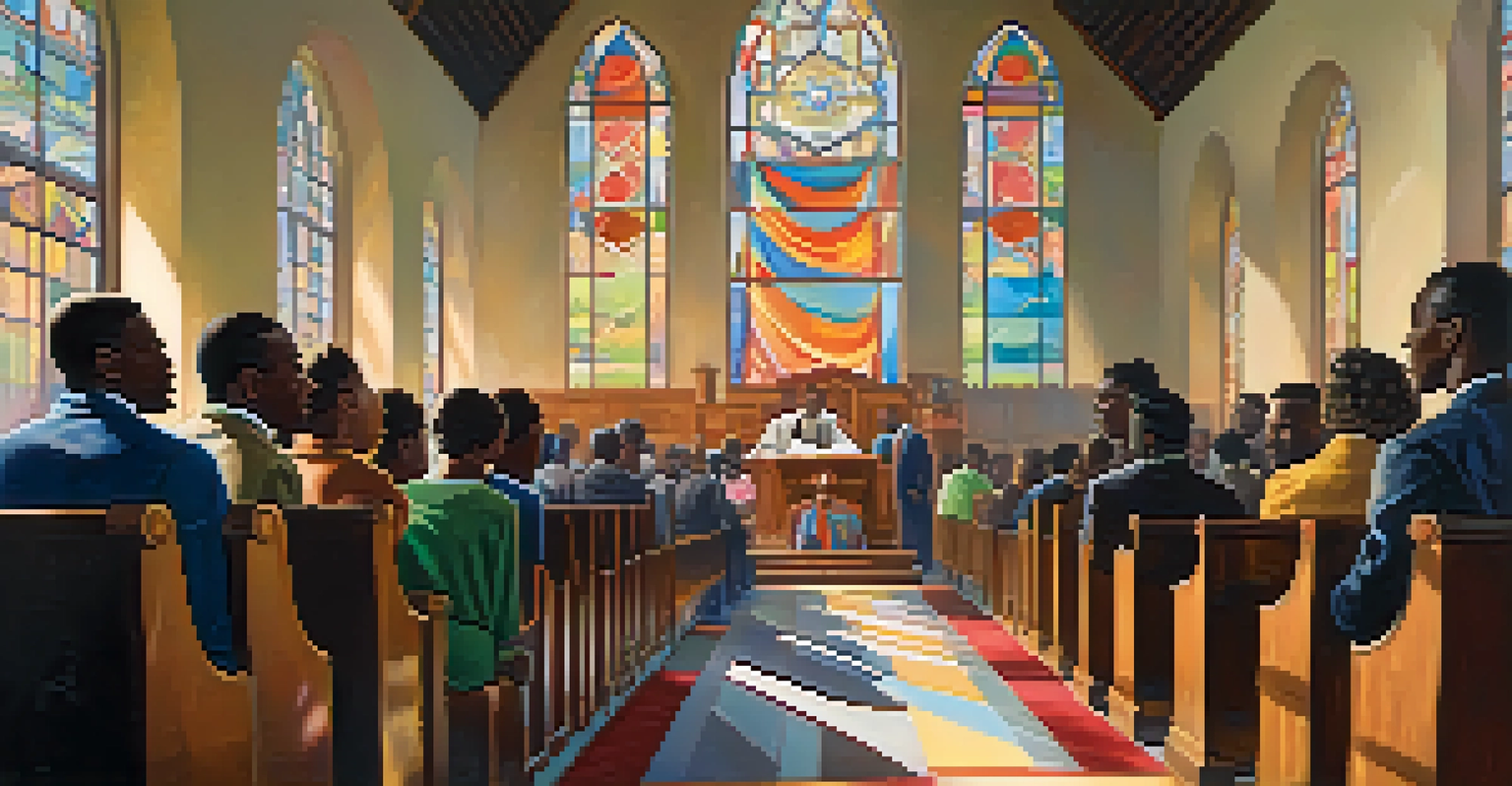The Great Migration and Its Impact on Chicago

Understanding the Great Migration's Origins
The Great Migration refers to the mass movement of African Americans from the rural South to urban centers in the North between 1916 and 1970. This migration was primarily driven by the search for better job opportunities and the escape from oppressive Jim Crow laws. Families sought a new life free from the violence and discrimination that defined their Southern experience.
The Great Migration was not just about leaving the South; it was about creating a new life and identity in the North.
As they arrived in cities like Chicago, they brought with them rich cultural traditions, vibrant music, and culinary influences that would shape urban life. The promise of industrial jobs in factories and railroads attracted countless individuals eager for a fresh start. This movement was not just about relocation; it was about forging a new identity and seeking dignity in a rapidly changing world.
The migration also laid the groundwork for significant demographic shifts in urban areas. Chicago, in particular, saw a substantial increase in its African American population, which would later influence the city's social, political, and cultural landscape. Understanding these origins is crucial to grasping the full impact of the Great Migration.
Economic Opportunities and Challenges in Chicago
One of the main draws for migrants to Chicago was the promise of economic opportunity. The city was a hub of industry, offering jobs in meatpacking, manufacturing, and transportation. Many found work in factories that were desperately seeking labor, allowing them to earn wages that were often higher than what they could make in the South.

However, the influx of new residents also led to intense competition for jobs and housing. While many African Americans secured better employment, they often faced discrimination and wage disparities compared to their white counterparts. This economic struggle highlighted the ongoing challenges of inequality that persisted even in the North.
Economic Opportunities in Chicago
The Great Migration led many African Americans to Chicago in search of better job opportunities, despite facing challenges like discrimination and wage disparities.
Despite these challenges, the economic contributions of migrants helped to fuel Chicago's growth. Their labor was essential in making the city a bustling industrial center, and over time, they began to establish their own businesses, contributing to a vibrant economy. This resilience in the face of adversity is a testament to the spirit of those who migrated.
Cultural Contributions of Migrants to Chicago
The Great Migration profoundly influenced the cultural landscape of Chicago, particularly in the realms of music, art, and literature. Migrants brought with them the soulful sounds of blues and jazz, which would thrive in the city's clubs and bars. This musical evolution gave rise to iconic figures such as Muddy Waters and Louis Armstrong.
The struggle for equality is not a sprint, but a marathon, one that requires the collective effort of the community.
As these cultural expressions flourished, so did the arts. The emergence of the Chicago Renaissance in the 1920s showcased black artists, writers, and thinkers who contributed to a rich cultural dialogue. This period not only celebrated African American culture but also challenged prevailing stereotypes and showcased the community's intellectual prowess.
Moreover, the culinary landscape transformed as Southern cuisine made its way to Chicago. Dishes like fried chicken, collard greens, and gumbo became staples, enriching the city's food culture. These contributions forged a unique identity that resonated with residents and visitors alike, illustrating how migration can shape a city's cultural fabric.
The Role of Community in Shaping Identity
Community played a vital role in the lives of migrants settling in Chicago. Many sought out neighborhoods with established African American populations, such as Bronzeville, where they could find support and solidarity. These neighborhoods became cultural epicenters, fostering connections and a sense of belonging.
Churches and social organizations emerged as critical pillars of these communities, providing not only spiritual guidance but also resources for education and employment. These institutions became spaces for activism, where leaders rallied for civil rights and community improvement. The sense of unity within these neighborhoods laid the groundwork for future social movements.
Cultural Transformation through Migration
Migrants significantly enriched Chicago's cultural landscape, introducing vibrant music, art, and Southern cuisine that shaped the city's identity.
Additionally, the creation of cultural festivals and events highlighted the rich traditions brought by migrants. These gatherings celebrated heritage, arts, and local cuisine, forging a strong communal identity. The importance of community in this context cannot be overstated; it was a lifeline that helped individuals navigate the complexities of urban life.
The Impact on Chicago's Political Landscape
The Great Migration also had significant implications for Chicago's political landscape. As the African American population grew, so did their political power. Newly settled migrants began to engage in civic activities, forming alliances and advocating for their rights. This shift marked a pivotal moment in the city's governance.
The demand for better housing, education, and employment opportunities led to increased political activism. Organizations like the Chicago Urban League emerged to address systemic inequalities and empower black citizens. Through grassroots efforts, they fought for representation and policies that would benefit their communities.
As a result, Chicago witnessed the election of its first African American mayor, Harold Washington, in the 1980s, a testament to the political evolution spurred by the Great Migration. This moment not only reflected the growing influence of African Americans in the city but also underscored the importance of participation in the democratic process.
Challenges Faced by Migrants in Urban Chicago
Despite the opportunities that Chicago presented, many migrants faced significant challenges in their new urban environment. Housing discrimination was rampant, with real estate agents often refusing to rent to African Americans or charging exorbitant prices. This led to overcrowded living conditions and the development of segregated neighborhoods.
Public services and infrastructure often fell short in these communities, exacerbating issues related to poverty and unemployment. Schools were underfunded, and access to healthcare was limited, creating a cycle of disadvantage. This harsh reality highlighted the stark contrast between the promise of the North and the struggles on the ground.
Community's Role in Identity Formation
Strong community networks in neighborhoods like Bronzeville provided support and a sense of belonging, helping migrants navigate urban life and advocate for their rights.
Moreover, the social tensions arising from this migration sometimes erupted into violence, as seen in the race riots of 1919. These events underscored the challenges of integration and the deep-seated racial divisions that persisted. The resilience of the community in the face of such adversity is a powerful reminder of the ongoing fight for equality.
Legacy of the Great Migration in Modern Chicago
The legacy of the Great Migration continues to resonate in modern Chicago. The cultural contributions of migrants have become integral to the city’s identity, influencing everything from music and art to food and literature. Festivals celebrating this vibrant heritage are now staples of Chicago life, attracting diverse audiences.
Moreover, the political landscape shaped by this migration has paved the way for ongoing discussions about race, equity, and representation. Modern activists draw inspiration from the struggles and achievements of those who came before them, continuing the fight for social justice and community empowerment.

In many ways, the Great Migration laid the foundation for the rich tapestry of Chicago's multicultural identity. The city remains a place where diverse voices come together, reminding us that the journey of those migrants was not just about physical relocation but about forging a lasting impact on the urban landscape.